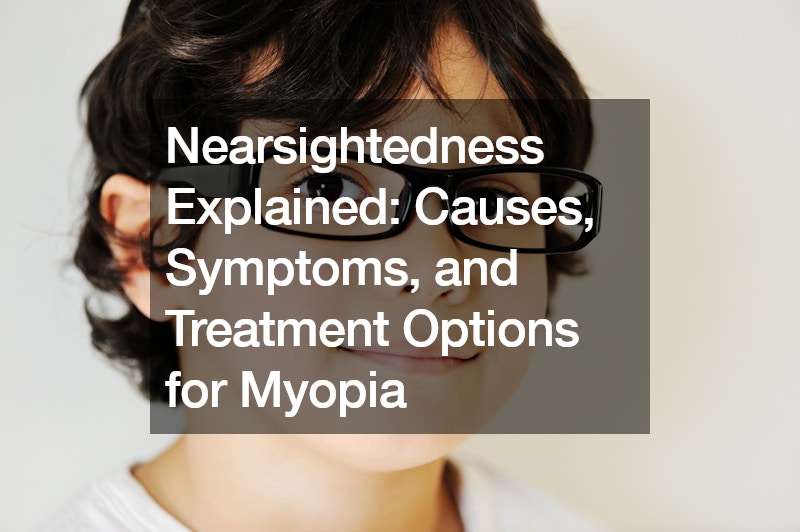
Nearsightedness, also known as myopia, is a prevalent vision condition affecting millions globally. People with myopia can see objects close up clearly, but distant objects appear blurry or out of focus. This can significantly impact daily activities like driving, watching television, or recognizing faces in a crowd.
While the exact cause of myopia remains under investigation, several factors contribute to its development.
Understanding the Focus Problem
The human eye relies on a precise focusing mechanism to create clear images. Light enters the eye through the cornea, the transparent dome at the front.
The lens, a flexible structure behind the cornea, then further bends the light rays, focusing them onto the retina, a light-sensitive layer at the back of the eye. The retina transmits these light signals to the brain, which interprets them as images.
In a healthy eye, the cornea and lens work together to focus incoming light rays precisely onto the retina. However, in myopia, this focusing process goes awry. This can occur due to two main reasons:
- Eyeball Shape: An eyeball that is slightly longer than normal causes the light rays to focus in front of the retina instead of directly on it.
- Lens Shape: A lens that is abnormally shaped can also prevent proper light focusing on the retina.
Risk Factors and Development
Genetics plays a significant role in myopia development. If one parent has myopia, the child has a higher risk of inheriting it. This risk further increases if both parents are nearsighted.
Environmental factors may also contribute to myopia. Extensive near work, such as spending excessive time reading, using electronic devices, or studying for long periods, has been linked to an increased risk of myopia, especially in children.
Symptoms of Myopia
The most common symptoms of myopia include:
- Blurry vision for distant objects, such as difficulty seeing road signs, people’s faces across the room, or movie screens.
- Squinting to try to improve distant vision.
- Headaches, particularly after prolonged near work.
- Eye strain or fatigue.
- Difficulty seeing clearly at night.
Early Detection and Diagnosis
Early detection and diagnosis of myopia are crucial for ensuring optimal vision development, particularly in children. Regular eye examinations are recommended for everyone, but they become especially important for individuals with a family history of myopia or those experiencing symptoms suggestive of nearsightedness.
A comprehensive eye exam at an eye centre typically involves several tests, including:
- Visual acuity test: This measures your ability to see objects at different distances.
- Refraction test: This test determines the corrective lens power needed to improve your vision.
- Slit-lamp examination: This allows the eye doctor to examine the health of the cornea, lens, and other parts of the eye.
Treatment Options for Myopia
Fortunately, myopia is a highly treatable condition. Several effective options can help individuals with myopia achieve clear vision:
- Corrective Lenses: Eyeglasses and contact lenses are the most common and effective treatments for myopia. These lenses bend the light rays entering the eye, focusing them correctly onto the retina and providing clear vision.
- Refractive Surgery: In some cases, refractive surgery may be an option. These procedures use lasers or other techniques to reshape the cornea, permanently correcting the focusing issue. However, these surgeries are typically considered for adults whose myopia has stabilized.
Choosing the Right Treatment
The best treatment for myopia depends on several factors, including the severity of your condition, your lifestyle, and your personal preferences. Consulting an ophthalmologist or optometrist at an eye centre is crucial for determining the most suitable option for your needs. They can discuss the pros and cons of each treatment approach and help you make an informed decision.
Potential Complications of Untreated Myopia
While myopia itself is not a serious eye disease, leaving it uncorrected can lead to other vision problems in the long run. Some potential complications include:
- Strabismus: This condition, also known as crossed eyes, can occur when the brain struggles to process blurry images from both eyes.
- Amblyopia: Often referred to as lazy eye, amblyopia develops when one eye becomes weaker than the other due to uncorrected nearsightedness. Early intervention is crucial to prevent permanent vision loss in the weaker eye.
- Glaucoma: This is a group of eye diseases that damage the optic nerve, potentially leading to vision loss. While not directly caused by myopia, individuals with high myopia are at an increased risk of developing glaucoma.
- Retinal detachment: In severe cases of myopia, the excessive stretching of the eyeball can increase the risk of retinal detachment, a serious condition requiring immediate medical attention.
Looking Forward
Research into myopia continues, with scientists exploring potential ways to prevent or slow its progression. This might include medications, specialized contact lenses, or specific vision therapy techniques. While these are not yet mainstream options, they offer promising prospects for the future of myopia management.
Conclusion
Nearsightedness is a widespread vision condition that can be effectively addressed with proper diagnosis and treatment. By understanding the causes, symptoms, and available treatment options, you can take control of your vision health and ensure clear sight for a lifetime. Remember, early detection and intervention are key to managing myopia effectively and preventing potential complications. If you experience any signs of nearsightedness, schedule an appointment with an eye doctor to discuss the best course of action for you.
.




